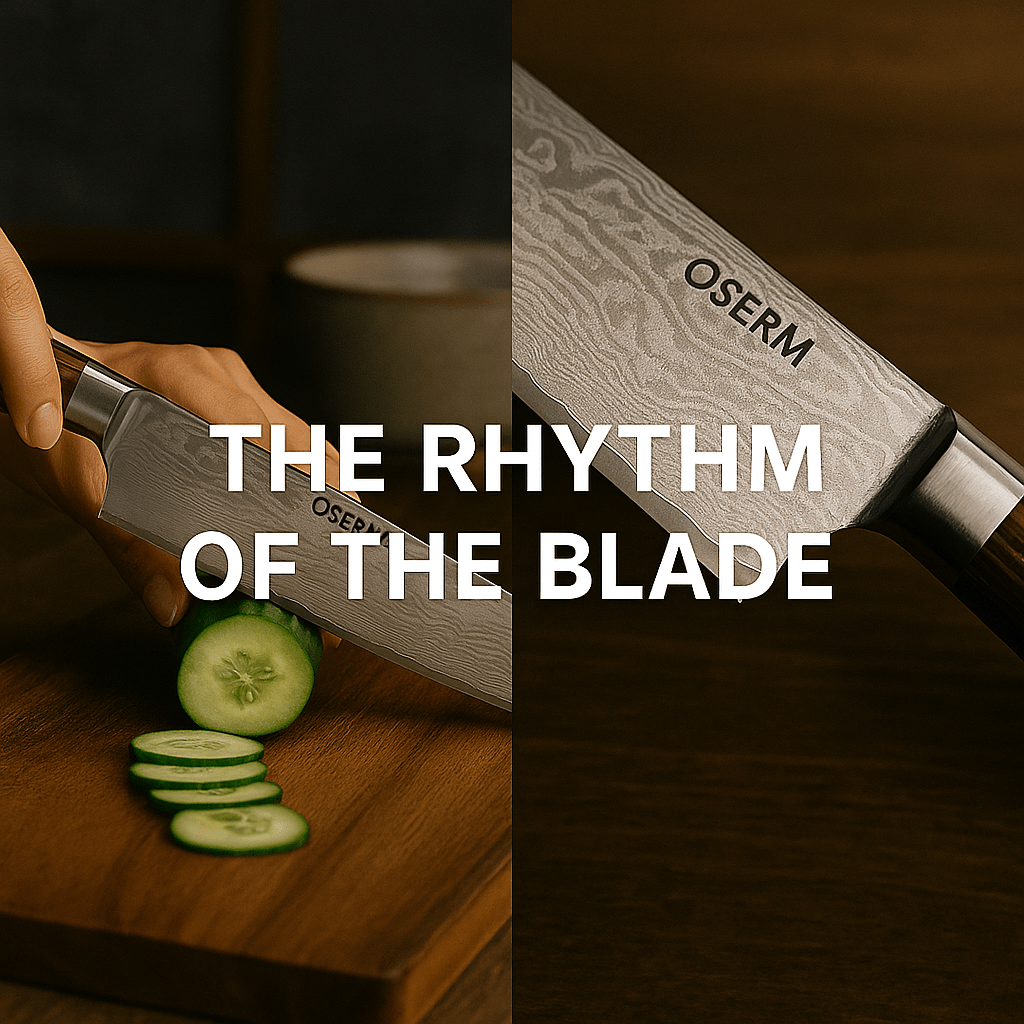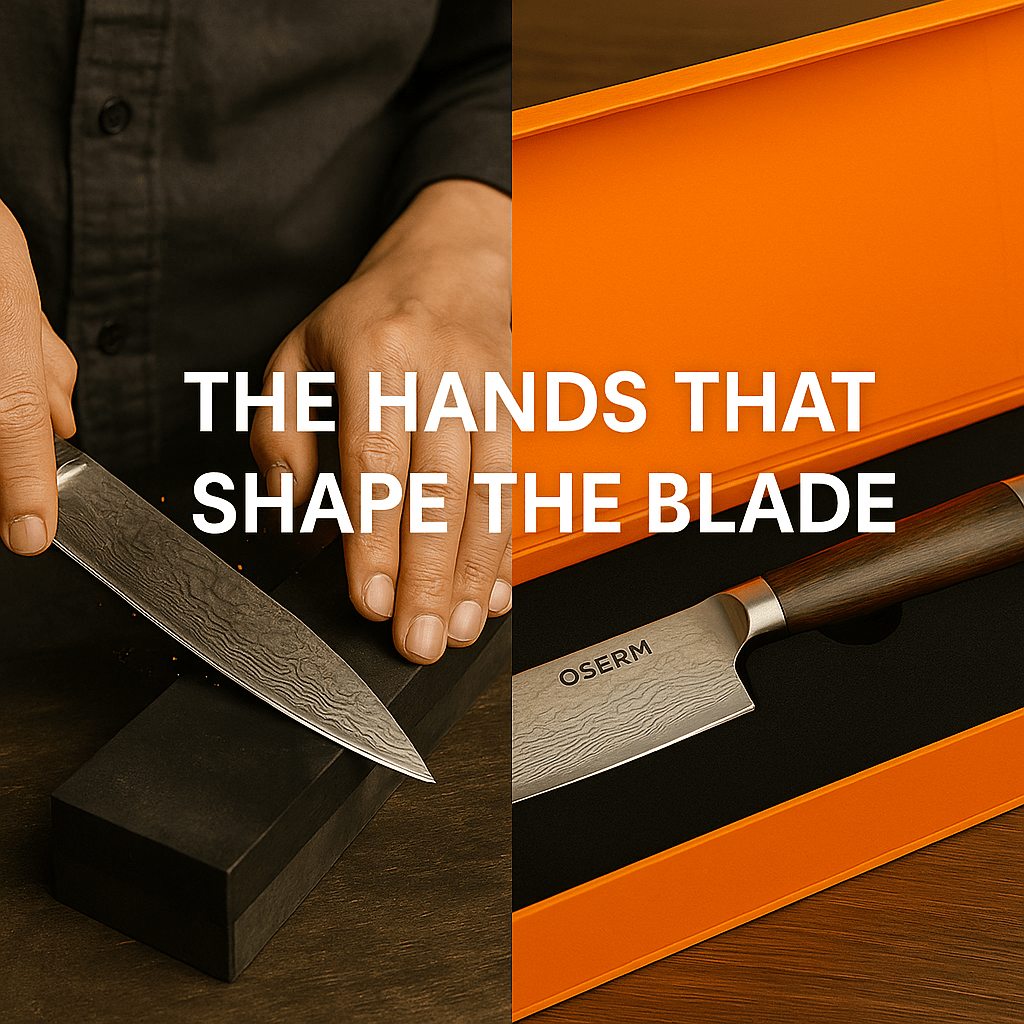Article: The Rhythm of the Blade – How a Fine Knife Teaches Us the Pace of Life

The Rhythm of the Blade – How a Fine Knife Teaches Us the Pace of Life
In a world obsessed with speed, efficiency, and instant results, the kitchen may be one of the last places where time still feels honest. Here, flavors need patience, ingredients demand care, and tools respond to rhythm — not rush. Among all the tools in the kitchen, a fine knife is the one that best reveals this truth. A well-balanced blade like an OSERM Damascus knife doesn’t simply cut; it teaches us how to move, how to breathe, and how to return to the present moment.
This is the quiet power of craftsmanship: it gives pace to our hands, clarity to our senses, and rhythm to our lives.
1. The Pace of Craft – Why a Knife Is Never Truly “Fast”
Even the sharpest knife in the world does not exist for speed — it exists for precision. In cooking, precision means presence. It means slowing just enough to feel the resistance of the vegetable, to sense the angle of the blade, to hear the subtle change in sound when the edge glides perfectly.
Speed is a by-product, not a goal. A chef becomes fast only after becoming attentive. This is why the first lesson of any culinary school begins not with fire or flavor, but with knife skills. A knife teaches focus long before it teaches technique.
With an OSERM knife, this rhythm becomes intuitive. The handle settles into your palm. The blade responds to the smallest adjustments. Your motions become smoother, quieter — almost meditative. In this calm, the world’s noise fades, and only the ingredient and the moment remain.
2. The Rhythm Hidden in Damascus Steel
The wave-like Damascus patterns are more than beauty — they are a visual record of rhythm. Each fold is the result of countless repeated motions, hammered with patience, shaped with breath-like consistency. This pattern is time solidified into steel.
When you cut with a Damascus blade, you join that rhythm. The steadiness of the craftsman’s hand becomes the steadiness of yours. Their discipline becomes your clarity. The blade carries hundreds of hours of artisan work — and in your kitchen, those hours guide your motion, silently and gracefully.
3. Cooking as a Conversation with Time
Time behaves differently when you cook. It stretches during simmering, contracts during preparation, and disappears when you lose yourself in the motion of cutting. A great knife amplifies this experience.
With a dull or poorly balanced knife, you fight the ingredient. With an OSERM knife, you collaborate with it. You feel the weight shift, the smooth descent, the soft sound of the blade reaching the board. These micro-moments awaken the senses — sight, sound, touch, rhythm.
Cooking becomes less of a task, more of a dialogue. And in that dialogue, you rediscover time — not as pressure, but as presence.
4. Why a Knife Changes the Way We Move
Human movement adapts to the tools we rely on. A heavy knife slows us. A poorly sharpened one frustrates us. A beautifully balanced blade invites flow, grace, and confidence.
This is why so many OSERM customers say their cooking “suddenly feels smoother.” It’s not magic — it’s ergonomics meeting craftsmanship. The blade’s geometry reduces friction. The VG-10 steel core maintains keenness. The polished spine rests comfortably against the finger. The handle’s resin-wood composition warms naturally in the hand.
All these details reshape how your body moves — turning daily cooking into a ceremony of fluidity.
5. The Psychology of Slowing Down
Modern life rarely asks us to slow down. Yet slowing down is essential for clarity, creativity, and emotional balance. A knife — simple, humble, ancient — becomes one of the most unexpected gateways into that state.
With every cut, your attention sharpens. Your breathing steadies. Your thoughts realign. This act, repeated daily, becomes its own form of meditation — a grounding ritual that reconnects you to your senses and restores a sense of calm.
When a tool helps you return to yourself, that tool transcends function. It becomes a companion for the mind.
6. A Knife’s Rhythm Becomes a Life Rhythm
The more you cook with a well-crafted knife, the more your rhythm changes. You learn to appreciate the small details: the fragrance released at the exact moment of slicing herbs, the transparency of a finely cut onion, the clean glide of steel through fresh fish.
Over time, this rhythm extends beyond the kitchen. You notice more, rush less, and move through the day with greater intentionality. A knife teaches patience — not through words, but through experience.
7. OSERM’s Philosophy – Tools That Restore Harmony
Every OSERM knife is designed with this rhythm in mind. The 67-layer Damascus steel isn’t only for beauty; it’s for balance. The orange OSERM gift box isn’t only for presentation; it’s for ritual. The handcrafted finish isn’t only for performance; it’s for connection.
We create knives not just to cut food, but to help people reconnect with time, craft, and themselves. A knife that feels right doesn’t simply improve cooking — it improves the cook.
Weekly Deal 🔥
Discover the rhythm of craftsmanship with the OSERM Damascus Collection. A blade designed to bring calm, clarity, and beauty to your kitchen — and to your life.
You Might Also Like
- The Hands That Shape the Blade – Why Human Touch Still Matters in a Machine-Made World
- Beyond the Edge – How a Knife Carries Time, Memory, and Meaning
- The Fire Within – How Heat Shapes Steel and Spirit
Tags: OSERM Damascus knives, craftsmanship, kitchen rhythm, VG-10 steel, culinary mindfulness, knife balance, slow living, orange gift box, Japanese design philosophy





